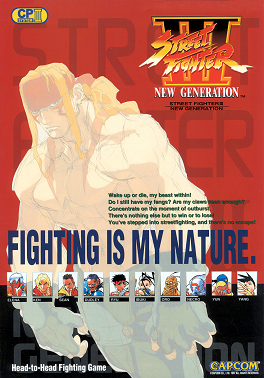Street Fighter III: Second Impact
| Street Fighter III | |
|---|---|

European arcade flyer
|
|
| Developer(s) | Capcom |
| Publisher(s) | Capcom Virgin Interactive (EU) |
| Producer(s) | Tomoshi Sadamoto |
| Designer(s) | Yasuhiro Seto Tomonori Ohmura Obata Shinichiro |
| Programmer(s) | Kazuhito Nakai Tate Yas |
| Artist(s) | Ball Boy Q Yu-suke D Kurita |
| Composer(s) | Hideki Okugawa Yuki Iwai |
| Series | Street Fighter |
| Platform(s) | Arcade, Dreamcast |
| Release |
Arcade Dreamcast
|
| Genre(s) | Fighting |
| Mode(s) | Up to 2 players simultaneously |
| Cabinet | Upright |
| Arcade system | CP System III |
| Display |
Raster, 384 x 224 (Horizontal), 32,768 colors on screen, 16 million color palette |
Street Fighter III: New Generation (ストリートファイターⅢ NEW GENERATION) is a fighting video game in Capcom's Street Fighter series, originally released as coin-operated arcade game in 1997. Street Fighter III was produced for the CD-ROM-based CP System III hardware, which allowed for more elaborate 2D graphics than the CPS II-based Street Fighter Alpha games (the previous incarnation of the Street Fighter series), while revamping many of the play mechanics. The game, which was designed as a direct sequel to Street Fighter II, initially discarded every previous character except for Ryu and Ken (hence the "New Generation" subtitle), introducing an all-new roster led by Alex. Likewise, a new antagonist named Gill took over M. Bison's role from the previous games as the new boss character.
Street Fighter III was followed by two updates: Street Fighter III 2nd Impact in 1997 and Street Fighter III 3rd Strike in 1999. A single home version of the game was released for the Dreamcast in a two-in-one compilation titled Street Fighter III: Double Impact, which also included 2nd Impact.
...
Wikipedia
